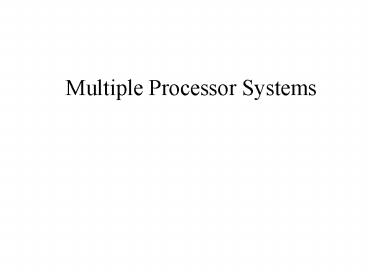Multiple Processor Systems - PowerPoint PPT Presentation
Title:
Multiple Processor Systems
Description:
A computer system in which two or more CPUs share full access to a common RAM ... NUMA Multiprocessor Characteristics. Single address space visible to all CPUs ... – PowerPoint PPT presentation
Number of Views:40
Avg rating:3.0/5.0
Title: Multiple Processor Systems
1
Multiple Processor Systems
2
Multiprocessor Systems
- Continuous need for faster computers
- shared memory model ( access nsec)
- message passing multiprocessor (access microsec)
- wide area distributed system (access msec)
3
Multiprocessors
- DefinitionA computer system in which two or
more CPUs share full access to a common RAM
4
Multiprocessor Hardware (1)
- Bus-based multiprocessors
5
Multiprocessor Hardware (2)
- UMA(Uniform Memory Access) Multiprocessor using a
crossbar switch (nn crosspoints)
6
Multiprocessor Hardware (3)
- UMA multiprocessors using multistage switching
networks can be built from 2x2 switches - (a) 2x2 switch (b) Message format
7
Multiprocessor Hardware (4)
- Omega Switching Network (n/2 ln2 n switches)
8
Multiprocessor Hardware (5)
- NUMA Multiprocessor Characteristics
- Single address space visible to all CPUs
- Access to remote memory via commands
- LOAD
- STORE
- Access to remote memory slower than to local
9
Multiprocessor OS Types (1)
Bus
- Each CPU has its own operating system
- System calls caught and handle on its own CPU
- No sharing of process
- No sharing of pages
- Multiple independent buffer caches
10
Multiprocessor OS Types (2)
Bus
- Master-Slave multiprocessors
- Master is a bottleneck
- It fails for large multiprocessors
11
Multiprocessor OS Types (3)
Bus
- SMP - Symmetric MultiProcessors
- Only one CPU at a time can run the operating
system - ?operating system splitted in critical regions
12
Multiprocessor Synchronization (1)
- TSL(test and set lock) instruction can fail if
bus already locked - TSL must first lock the bus
13
Multiprocessor Synchronization (2)
- Multiple locks used to avoid cache thrashing
14
Multiprocessor Synchronization (3)
- Spinning versus Switching
- In some cases CPU must wait
- waits to acquire ready list
- In other cases a choice exists
- spinning wastes CPU cycles
- switching uses up CPU cycles also
- possible to make separate decision each time
locked mutex encountered
15
Multiprocessor Scheduling
- Scheduling on a single processor is one
dimensional - Scheduling on a multiprocessor is two dimensional
16
Multiprocessor Scheduling (1)independent
processes
- Timesharing
- Note use of single data structure for scheduling
17
Multiprocessor Scheduling (2)related processes
- Space sharing
- multiple threads at same time across multiple CPUs
18
Multiprocessor Scheduling (3)time and space
sharing together
- Problem with communication between two threads
- both belong to process A
- both running out of phase
19
Multiprocessor Scheduling (4)
- Solution Gang Scheduling
- Groups of related threads scheduled as a unit (a
gang) - All members of gang run simultaneously
- on different timeshared CPUs
- All gang members start and end time slices
together - All CPUs scheduled synchronously.
20
Multiprocessor Scheduling (5)
- Gang Scheduling
21
Multicomputers
- DefinitionTightly-coupled CPUs that do not
share memory - Also known as
- cluster computers
- clusters of workstations (COWs, Farms)
22
Multicomputer Hardware (1)
- Interconnection topologies
- (a) single switch
- (b) ring
- (c) grid
- (d) double torus
- (e) cube
- (f) hypercube
23
Multicomputer Hardware (2)
- Switching scheme
- store-and-forward packet switching
24
Multicomputer Hardware (3)
- Network interface boards in a multicomputer
25
Low-Level Communication Software (1)
- If several processes running on node
- need network access to send packets
- Map interface board to all process that need it
- If kernel needs access to network
- Use two network boards
- one to user space, one to kernel
26
Low-Level Communication Software (2)
- Node to Network Interface Communication
- Use send receive rings
- coordinates main CPU with on-board CPU
27
User Level Communication Software
- Minimum services provided
- send and receive commands
- These are blocking (synchronous) calls
- Cpu idle during transmission
- Non blocking calls
- with copy
- with interrupt
- copy on write
(a) Blocking send call
(b) Nonblocking send call
28
Remote Procedure Call (1)
- Steps in making a remote procedure call
- the stubs are shaded gray
29
Remote Procedure Call (2)
- Implementation Issues
- Cannot pass pointers
- call by reference becomes copy-restore (but might
fail) - Weakly typed languages
- client stub cannot determine size
- Not always possible to determine parameter types
- Cannot use global variables
- may get moved to remote machine
30
Distributed Shared Memory (1)
- Note layers where it can be implemented
- hardware
- operating system
- user-level software
31
Distributed Shared Memory (2)
- Replication
- (a) Pages distributed on 4 machines
- (b) CPU 0 reads page 10
- (c) CPU 1 reads page 10
32
Distributed Shared Memory (3)
- False Sharing
- Must also achieve sequential consistency
33
Multicomputer SchedulingLoad Balancing (1)
Process
- Graph-theoretic deterministic algorithm
34
Load Balancing (2)
- Sender-initiated distributed heuristic algorithm
- overloaded sender
35
Load Balancing (3)
- Receiver-initiated distributed heuristic
algorithm - under loaded receiver































